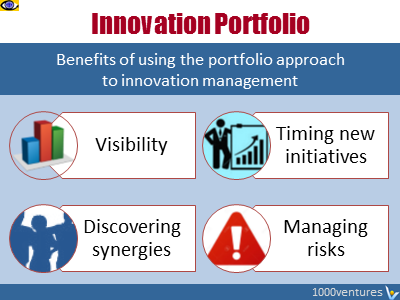|
| |
Portfolio is much more than just a list of
initiatives. You should also create charts that compare these initiatives
across dimensions such as stretch, strategic fit, risk, potential return and
resource requirements.
By using different charts as lenses to compare
initiatives, you can mix and match alternatives until you come up with the
portfolio that's the best for your firm. |
|
 |
| |
Timing of New Initiatives
The innovation portfolio will help you
time when you start a new initiative or transfer a completed one into
manufacturing or the marketplace.
|
|
80/20
Principle
Achieve More with INNOBALL
|
|
|
|
3 Primary Criteria to Assess Your Innovation
Portfolio1 |
|
Besides assessing each initiative
individually for risk, investment, return, and timing, assess your
total portfolio to ensure that you have the right initiatives in it:
-
→
Stretch
and strategic fit.
How much does your portfolio push the industry frontiers, and
how well does it fit with your business goals and
strategy?
>>>
-
Capabilities and capacity.
Do you have the required
→
capabilities to
executive the portfolio and do you have enough of them? No
innovation strategy or portfolio is meaningful if don’t possess
the capabilities and capacity to execute it. When the demand for
resources exceeds their supply, a bottleneck forms and work
grinds to a halt. To address this problem,
Silicon Valley firms use two basic approaches: (1) they load
their innovation system to no more than 85% of the actual
capacity, and (2) classify innovation initiatives into broad
categories, determined by size and skill requirement, and then
create templates that summarize the resource and capability
requirements for completing each type.
-
Leverage and risk. Have you
leveraged your investments so that you have a productivity
advantage, while keeping risk within acceptable bounds? Leverage
is what separates winners and losers. You can get leverage, for
instance, from a
platform product, a core product design that
can be tailored with small changes to meet many different
customer applications. Internally, by migrating to a common
platform, you will be able to concentrate employees’ learning on
a single product architecture. The platform approach also
reduces the number of suppliers that you rely upon, increasing
your cost leverage: the same parts can be used repeatedly. The
platform strategy also means that when you undertake a new
derivative, the degree of change is sufficiently small that is
also confines risk and increases reliability.
"Most
→
innovators
are successful to the extent to which they define risks and confine
them."
~
Peter Drucker
|
'
References:
1.
Relentless Growth, Christopher Meyer
2.
"Modern Management", Ninth Edition, Samuel C. Certo
|
Achieving the Right Balance
Between Stretch and Strategic Fit
The first test for any innovation portfolio is
achieving
the right balance between stretch and strategic fit. If you engage in
hyperreactiveness thinking and continually react to the latest market or
technological
trend, rather than following a course until there is a
significant reason to change, you’ll fail. The key to avoiding such
short-term thinking is to maintain
strategic alignment and test the assumptions that drive new products and
service decisions as you make these choices.
>>>
 KoRe 10 Innovative
Thinking Tools
KoRe 10 Innovative
Thinking Tools
The
KoRe 10 Metaphoric Tools
help you
invent new things,
anticipate market shifts and your opponents' moves, find creative
→
solutions
to a complex problem design
a
→
synergistic
innovation
strategy...
More
 Silicon
Valley Companies Silicon
Valley Companies
How to decide If your innovation portfolio has
enough stretch? Silicon Valley firms use the following methods...
More
 Apple Apple
When Steve Jobs returned to Apple in 1997, he
looked at the number of proposed research and development projects. Then he
stopped most of them. Today, the Apple
brand is known for
its lean
venture strategies, small but value-added product range and
great launch program...
More
 Corning Corning
Project selection is a highly
competitive and tightly managed process – not all projects get funded.
For new high-risk and high-potential-return projects, project teams work
hard to find opportunities for lowering costs and reducing risks.
CEO
and the corporate
executive
team formally review individual projects three times a year, making
decisions about the portfolio...
More |
|